Despite being a household name for years now, it still feels like we don’t know much about Kyle Tucker.
He first appeared on top 100 prospect lists in 2017 and was a consensus top 10 choice heading into 2018. As the Astros ascended to super-team status and searched for aces to solidify their playoff rotation, Tucker commonly surfaced in trade rumors, yet he stayed put as Houston shipped off other farmhands to acquire the trio of Justin Verlander, Gerrit Cole, and Zack Greinke.
The left fielder got matching 72-plate-appearance cups of coffee with the big league club in 2018 and 2019, posting a woeful .439 OPS in the former but a promising .857 mark in the latter. With a .537 slugging percentage in his 2019 stint, Tucker displayed the power that was reputed to be his carrying tool and capitalized on his first taste of everyday playing time with 27 extra-base hits in the abbreviated 2020 season, tied for sixth in the American League.
And now, with less than 400 MLB plate appearances under his belt, he’s the core building block of Houston’s outfield. Although the Astros recently re-signed Michael Brantley, the free agencies of George Springer and Josh Reddick leave the team with little depth, with the underwhelming and unproven duo of Miles Straw and Chas McCormick currently slated for significant roles.
Bouncebacks from established stars like Carlos Correa and Jose Altuve would go a long way towards Houston reclaiming the AL West title, but solidifying Tucker’s role as a viable contributor and potentially more would arguably mean more for the team’s long-term outlook. So with that in mind, let’s take a look at what he’s shown in the majors so far.
Hit the Heaters
Tucker’s success at the plate in 2020 (a .268/.325/.512 triple-slash line, good for a 125 wRC+) can be explained very simply – he crushed four-seam fastballs. Pitchers challenged him with heaters just under 30 percent of the time, but Tucker’s 15 runs of value against them (per Statcast) was the fourth-highest mark in baseball, and his per-pitch value ranked sixth.
| Player | Run Value (Total) | RV / 100 | BA | SLG | Whiff % |
|---|---|---|---|---|---|
| Marcell Ozuna | 18 | 6.8 | 0.500 | 0.948 | 21.2% |
| Freddie Freeman | 17 | 5.9 | 0.463 | 0.896 | 12.2% |
| Jackie Bradley Jr. | 15 | 4.6 | 0.440 | 0.680 | 20.3% |
| Kyle Tucker | 15 | 5.7 | 0.361 | 0.750 | 12.5% |
| Jeimer Candelario | 12 | 3.8 | 0.368 | 0.553 | 22.2% |
| Eloy Jiménez | 12 | 5.7 | 0.356 | 0.780 | 20.3% |
| Ryan McMahon | 11 | 3.2 | 0.316 | 0.719 | 23.8% |
| Chris Taylor | 10 | 3.7 | 0.356 | 0.610 | 24.4% |
| Xander Bogaerts | 9 | 2.9 | 0.394 | 0.732 | 16.4% |
| Bryce Harper | 9 | 2.8 | 0.293 | 0.793 | 26.7% |
That’s a list mostly comprised of notable sluggers, with a few surprises sprinkled in. To some extent, Tucker was fortunate to reach that level of production on four-seamers, as the +.114 differential between his wOBA and xwOBA was the 15th-highest mark in the league.
Even if we took his results at face value, though, how repeatable is production against a specific pitch type? Certain hitters undoubtedly get reputations as “fastball hitters” or “breaking-ball hitters”, but it bears asking how this adage stands up to further scrutiny.
To assess this, I took the per-100-pitch run values for everyone who saw at least 450 four-seamers in 2019 and 200 in 2020, which yielded a sample of 153 hitters (for context, 142 hitters qualified for the batting title in 2020). Then, I looked at the year-over-year correlation in run values to see if hitters who did well (or poorly) in one year continued to do well (or poorly) in the next season.
Tucker himself did not qualify due to his tiny 2019 sample, but the overall trend was fairly weak – a small positive correlation of .15 (the two outliers in the upper-right are Ozuna and Freeman).
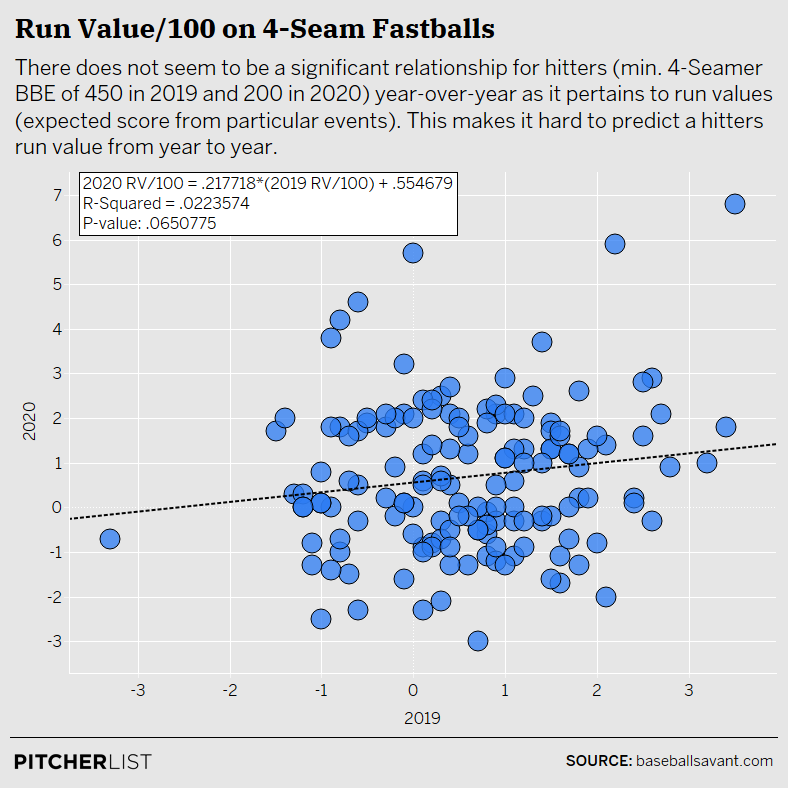
Data Visualization by @Kollauf on Twitter
Tucker’s low whiff rate of 12.5% against four-seamers is an encouraging sign. However, with his actual results outstripping his expected ones by a significant margin and the lack of stickiness on fastball production, he seems unlikely to remain an elite four-seam masher going forward. He was roughly average against all other pitch types graded in 2020, with a moderate level of success against curveballs and changeups negated by struggles with sliders and sinkers.
Swing Where You Can Do Damage, Take Where You Can’t
Although Tucker’s plate discipline was never considered elite, he was not known as a free swinger and compiled a walk rate of nearly 11% in more than 1,000 Triple-A plate appearances. That’s fallen to 7.5% so far in the majors, a few points below league average and enough to make him heavily reliant on powerful contact for production at the plate.
But let’s look under the hood and dig into his approach and swing decisions. In general, good hitters separate themselves by inflicting damage when pitchers venture into the middle of the strike zone, and by not helping pitchers out with chases on the edges of the zone.
Well, that’s exactly what Tucker did in 2020. Notice how his swing heatmap features a heavy concentration of dark red (indicating more swings) smack in the middle of the zone, while the take heatmap shows his willingness to let low-and-away borderline pitches go by.
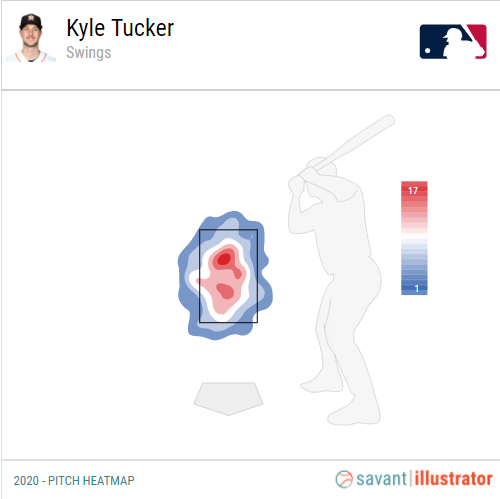
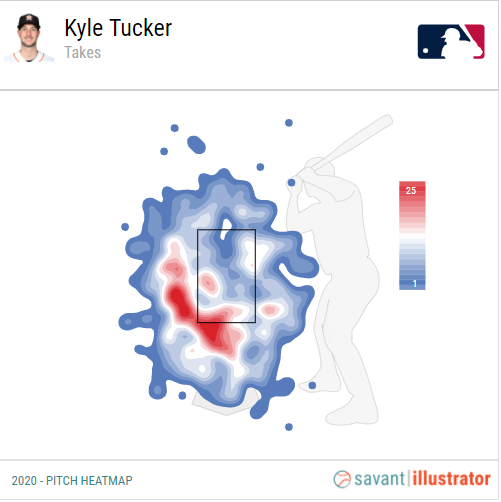
By making better swing decisions, Tucker naturally set himself up to make more, and better, contact. He raised his contact rate to 80% in 2020, well above the league average of 75% and a bump up from his combined 76% in 2018-2019. With fairly low whiff rates (70th percentile, per StatCast) and well-located swings leading to a 77th percentile Hard Hit rate, it’s no surprise that he did more damage in areas where he swung often (middle of the plate, up in the strike zone), and limited swings in zones where his contact was weak (low and away).
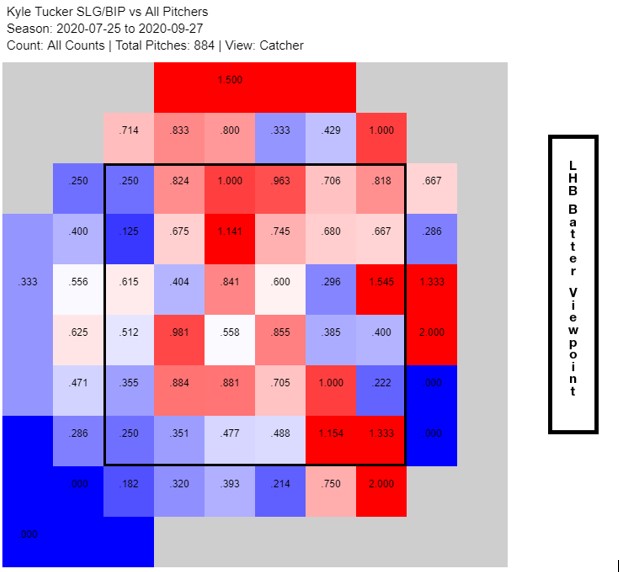
In terms of batted ball distribution, Tucker has a pretty extreme pull profile – his grounders almost exclusively went to the right side and only five of his 27 extra-base hits were to the opposite field. He was shifted against in nearly 75% of his 2020 plate appearances, so maintaining strong swing/take decisions is key to him continuing to access the pulled fly balls that drove his strong 2020 batting line and limiting the barrage of 4-3 (or 5-3) grounders into the shift.
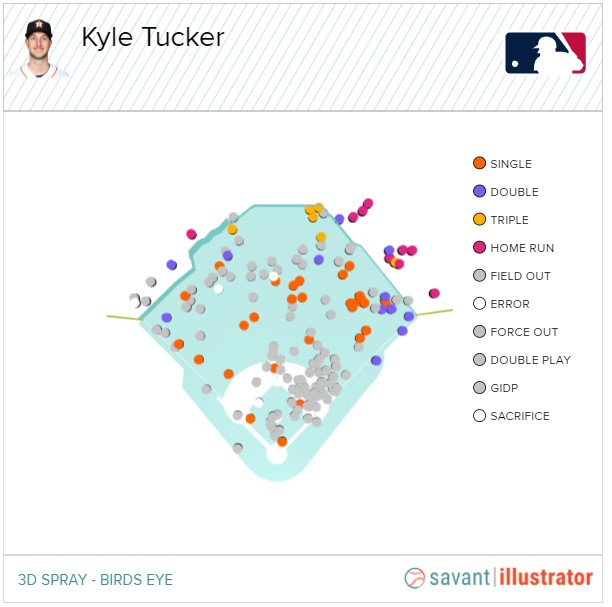
Well-Rounded Baserunning and Defense
For someone with a power-heavy, corner outfield profile, Tucker is also fairly athletic and has shown the potential to be a plus contributor both on the bases and in the outfield. Per Statcast, he had 70th percentile sprint speed and used his legs to steal eight bases while being caught just once. This was not a new development, either; Tucker was 6-for-7 in MLB stolen base attempts coming into 2020 and has a strong minor league track record of swiping more than a handful of bags with a high success rate.
| Year | Levels | SB | CS | Success Rate |
|---|---|---|---|---|
| 2015 | Rookie | 18 | 4 | 82% |
| 2016 | A, A+ | 32 | 12 | 73% |
| 2017 | A+, AA | 21 | 9 | 70% |
| 2018 | AAA, MLB | 21 | 5 | 81% |
| 2019 | AAA, MLB | 35 | 5 | 88% |
| 2020 | MLB | 8 | 1 | 89% |
Baserunning is more than just stealing bases, though, and Tucker shined in those areas, as well. He ranked seventh in FanGraphs’ all-encompassing baserunning metric (BsR) with 3.2 runs of value. He also was one of 22 qualified hitters to grade out positively in each of its three subcomponents – advancing on balls in play, avoiding double plays, and stolen bases.
Defensively, Tucker saved four Outs Above Average (Statcast’s defensive metric), placing him in the 94th percentile overall and tops among left fielders. Most of that value came from coming in or to the third-base side, areas where the short-porch Crawford Boxes and being a lefty thrower likely aided him.
Tucker also graded out as above average by DRS and UZR, so while short-season defensive metrics should be taken with large error bars, there is at least some consensus that his fielding abilities are a net positive. The Astros seem to agree, as indications are that Tucker will slide over to right for 2021, moving up the defensive spectrum and covering significantly more turf.
Conclusion
Overall, there’s a lot to like about Tucker going forward. As a 23-year-old, he played at a roughly four-win pace in his first extended MLB exposure, which is no small feat. Nothing about his production seemed fluky or seems ripe for regression, and of course, he’s still young enough that you’d expect some natural improvement.
Tucker’s upside is limited somewhat by his pedestrian walk rate and the lack of an elite hit tool – it’s pretty difficult to be a star while running OBPs in the .320s. But by doing all the other things well (hitting for power, baserunning, and defense), he gives himself a solid floor to fall back on, and a variety of ways to contribute – something Houston badly needs that in its outfield right now.
(Photo by Juan DeLeon/Icon Sportswire)

Kyle Tucker has gotten every chance that he could possibly have ever gotten. He has gotten much more than a chance. No hitter benefited more from favorable lineup placement than Tucker in 2020. I think regression is certainly possible for 2021.
Tucker is trash in the OF. The fact that he mos around is probably evidence that HOU knows it. There is some really bad stuff going on with contemporary defensive metrics – I think they are rewarding bad play. I suspect that they are measuring something other than quality defense. I think that defensive metrics are highly regressive. How else would we de-value SS defense, have catchers sitting on a knee and have catchers and 1B playing CF?